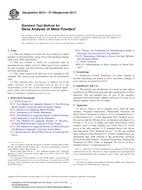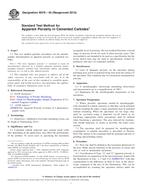Potřebujeme váš souhlas k využití jednotlivých dat, aby se vám mimo jiné mohly ukazovat informace týkající se vašich zájmů. Souhlas udělíte kliknutím na tlačítko „OK“.
ASTM B761-06(2011)
Standard Test Method for Particle Size Distribution of Metal Powders and Related Compounds by X-Ray Monitoring of Gravity Sedimentation
Automaticky přeložený název:
Standardní zkušební metoda pro Distribuce velikosti částic kovových prášků a souvisejících sloučenin X-Ray Sledování Gravity sedimentační
NORMA vydána dne 1.10.2011
Informace o normě:
Označení normy: ASTM B761-06(2011)
Poznámka: NEPLATNÁ
Datum vydání normy: 1.10.2011
Kód zboží: NS-8002
Počet stran: 4
Přibližná hmotnost: 12 g (0.03 liber)
Země: Americká technická norma
Kategorie: Technické normy ASTM
Kategorie - podobné normy:
Anotace textu normy ASTM B761-06(2011) :
Keywords:
metal powders, particle size, particle size distribution, powdered metals, refractory metal powders, sedimentation particle size distribution, ICS Number Code 77.160 (Powder metallurgy)
Doplňující informace
| Significance and Use | ||||||||||
|
This test method is useful to both suppliers and users of powders, as outlined in 1.1 and 1.2, in determining particle size distribution for product specifications, manufacturing control, development, and research. Users should be aware that sample concentrations used in this test method may not be what is considered ideal by some authorities, and that the range of this test method extends into the region where Brownian movement could be a factor in conventional sedimentation. Within the range of this test method, neither the sample concentration nor Brownian movement are believed to be significant. Reported particle size measurement is a function of both the actual particle dimension and shape factor as well as the particular physical or chemical properties being measured. Caution is required when comparing data from instruments operating on different physical or chemical parameters or with different particle size measurement ranges. Sample acquisition, handling, and preparation can also affect reported particle size results. |
||||||||||
| 1. Scope | ||||||||||
|
1.1 This test method covers the determination of particle size distributions of metal powders. Experience has shown that this test method is satisfactory for the analysis of elemental tungsten, tungsten carbide, molybdenum, and tantalum powders, all with an as-supplied Fisher number of 6 m or less, as determined by Test Method B 330. Other metal powders (for example, elemental metals, carbides, and nitrides) may be analyzed using this test method with caution as to significance until actual satisfactory experience is developed (see ). The procedure covers the determination of particle size distribution of the powder in the following two conditions: 1.1.1 As the powder is supplied (as-supplied), and 1.1.2 After the powder has been deagglomerated by rod milling as described in Practice B 859. 1.2 This test method is applicable to particles of uniform density and composition having a particle size distribution range of 0.1 up to 100 m. 1.2.1 However, the relationship between size and sedimentation velocity used in this test method assumes that particles sediment within the laminar flow regime. This requires that the particles sediment with a Reynolds number of 0.3 or less. Particle size distribution analysis for particles settling with a larger Reynolds number may be incorrect due to turbulent flow. Some materials covered by this test method may settle with Reynolds number greater than 0.3 if particles greater than 25 m are present. The user of this test method should calculate the Reynolds number of the largest particle expected to be present in order to judge the quality of obtained results. Reynolds number (Re) can be calculated using the flowing equationEquation 1 - Re = D3( - 0)0g/182whereD the diameter of the largest particle expected to be present, the particle density, 0the suspending liquid density, gthe acceleration due to gravity, and is the suspending liquid viscosity.A table of the largest particles that can be analyzed with Reynolds number of 0.3 or less in water at 35C is given for a number of metals in . A column of the Reynolds number calculated for a 30-m particle sedimenting in the same liquid system is given for each material also. This standard does not purport to address all of the safety concerns, if any, associated with its use. It is the responsibility of the user of this standard to establish appropriate safety and health practices and determine the applicability of regulatory limitations prior to use. Specific hazard information is given in Section 7. |
||||||||||
| 2. Referenced Documents | ||||||||||
|
Podobné normy:
Historická
1.10.2011
Historická
1.12.2010
Historická
1.11.2013
Historická
1.9.2010
Historická
1.4.2013
Historická
1.6.2014
Doporučujeme:
Aktualizace technických norem
Chcete mít jistotu, že používáte pouze platné technické normy?
Nabízíme Vám řešení, které Vám zajistí měsíční přehled o aktuálnosti norem, které používáte.
Chcete vědět více informací? Podívejte se na tuto stránku.



 ASTM B214-07(2011)..
ASTM B214-07(2011).. ASTM B215-10
ASTM B215-10 ASTM B243-13
ASTM B243-13 ASTM B276-05(2010)..
ASTM B276-05(2010).. ASTM B311-13
ASTM B311-13 ASTM B312-14
ASTM B312-14
 Cookies
Cookies
